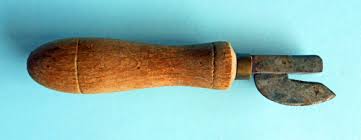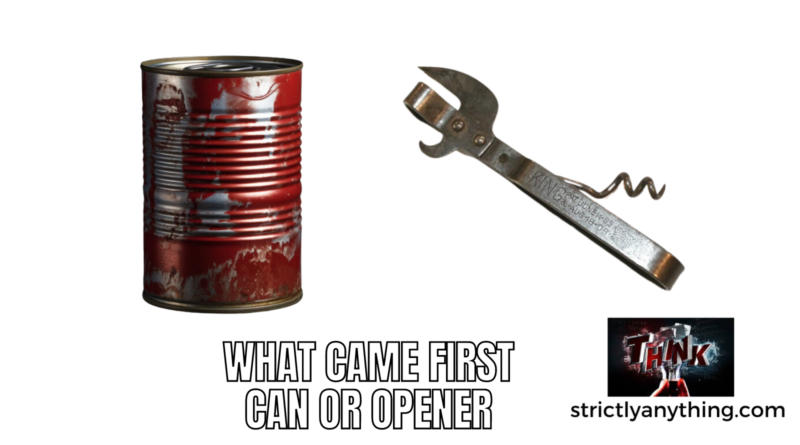What Came First The Can or The Can Opener
In 1795, Napoleon Bonaparte and the French government offered a hefty cash prize of 12,000 francs to anyone who could devise a safe and efficient method of preserving large amounts of food. The goal was to ensure that the French army, often in locations far from fresh food supplies, could access the nutrition they needed.
This challenge was taken up by Nicolas Appert, a French brewer and confectioner, who spent 14 years perfecting a method of sealing food into glass jars. The process involved placing food in a jar, sealing it, and then heating it to kill the bacteria that causes food to spoil. This invention, patented in 1810, was the foundation of modern canning.
Soon after, Peter Durand, a British merchant, received a patent in 1810 for preserving food using tin or other metals, rather than glass. This was the birth of the modern food can.
This was fantastic news! Now food could be preserved and stored.
But no-one could open them.
The First Can Opener
Canned food became increasingly popular, especially for military usage, but there wasn’t an immediate solution to opening these newfangled containers. Early instructions suggested using a chisel and hammer, which was hardly an ideal method. For several decades, consumers and soldiers struggled with inconvenient and often dangerous methods of opening their canned goods.
The solution didn’t come until almost 50 years after the introduction of the tin can. In 1855, Robert Yeates, a British cutlery and surgical instrument maker, patented the first known can opener. Yeates’ invention was a simple blade that could be pushed into the can, and then sawed around the edge to cut it open.
However, this rudimentary design was still hard to operate and not very efficient. The big breakthrough came in 1858 when Ezra J. Warner of Waterbury, Connecticut, in the United States, patented a much more practical device. Warner’s can opener used a pointed blade to pierce the can lid, then a curved blade was worked around the rim to cut it open. This “bayonet and sickle” model was adopted by the US military and used extensively during the Civil War.

Still, the perfect design for a can opener – one that was easy to use and safe – wasn’t found until the 20th century.

The now-iconic rotating wheel design was invented by William Lyman in 1870, but it was a design by Charles Arthur Bunker in the 1920s that finally struck the right balance between safety and efficiency. His model, called the Bunker Clancey, was the first to incorporate a cutting wheel that didn’t lead to jagged edges, thus decreasing the risk of injury.

From this point, the development of the can opener has been about refinement and added features, such as electric operation and the incorporation of bottle openers.
The history of the can opener is a fascinating tale of ingenuity and gradual refinement. From its humble beginnings as a tool of necessity in wartime to its status as a staple in virtually every kitchen worldwide, the can opener embodies the process of invention itself. Over the course of nearly two centuries, it has been reinvented, improved upon, and ultimately perfected, all while staying true to its original, essential purpose: making life a little bit easier.
Ezra J. Warner
Ezra J. Warner, an American inventor from Waterbury, Connecticut, is primarily known for his major contribution to the world of culinary gadgets – the invention of the first practical can opener.
Warner was born in 1805. Unfortunately, detailed information about his early life and education is limited, as was common for individuals from this period. What we do know is that by adulthood, Warner had a knack for invention and he applied his skills to practical problems.
His major breakthrough came in 1858, when he patented the U.S.’s first can opener. The invention was a response to a practical need. At that time, canned food had become increasingly popular, especially in the military, where it provided a way to preserve and transport food effectively. However, opening the cans was a challenging task, often requiring a hammer and chisel or other rudimentary, and potentially dangerous, tools.
Warner’s design was innovative and practical. It featured a pointed blade that would pierce the can lid, along with a secondary curved blade that could be worked around the rim to pry the lid off. This tool, often referred to as a “bayonet and sickle” model, was used extensively by the Union Army during the American Civil War. It represented a major step forward from the previous methods of opening cans and was the first can opener to see widespread use.
However, Warner’s can opener was not an immediate commercial success in households. It was still a relatively large and cumbersome device, and early canned goods were expensive and not yet commonplace in the average home. It wasn’t until smaller, more refined designs, like the one patented by William Lyman in 1870, came along that the can opener started to become a standard tool in the domestic kitchen.
Besides the can opener, Ezra Warner also held patents for a boot heel design and a corset clasp.
Ezra J. Warner died on January 16, 1871. While he might not have achieved fame during his lifetime, his invention of the can opener certainly left a legacy that persists in virtually every kitchen worldwide today.
William Lyman
William Lyman was an important figure in the development of everyday tools and devices, best known for his contribution to improving the can opener.
Born on February 27, 1821, in Middlefield, Connecticut, Lyman grew up in a world undergoing rapid industrial changes. The Industrial Revolution was in full swing during Lyman’s youth, a time that saw a burst of new inventions and manufacturing processes.
Lyman, drawn to this creative and practical world, grew to become an inventor himself. However, there is little available information about his early life, including his education and what may have spurred his interest in invention.
The defining achievement of Lyman’s life came in 1870, when he was nearly 50 years old. He designed and patented a can opener with a cutting wheel, a design element that was a significant step forward from the ‘bayonet and sickle’ style can openers that had been patented earlier by Ezra J. Warner. Lyman’s design was simpler and safer to use, and it closely resembles the can openers we still use today.
Lyman’s rotating wheel design represented a massive improvement in can opener technology. The user could easily puncture the can with the wheel, then rotate the tool around the edge to remove the lid. This was much safer and easier than trying to saw around the can’s edge, as was necessary with the earlier can openers.
In spite of this invention, Lyman led a relatively quiet life. After his patent was granted, there are few records detailing the remainder of his life. He passed away on September 15, 1891.
William Lyman’s name may not be widely known today, but his invention has undoubtedly had a profound impact on households worldwide. His can opener design has been slightly modified and improved over the years, but the fundamental principle of a rotating wheel cutting around the edge of the can remains the same. This practical, efficient tool is a testament to Lyman’s ingenuity and his contribution to the world of everyday convenience.
